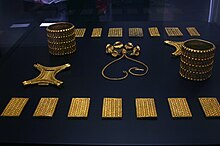Tartessos
Tartessos ( Greek Ταρτησσός ) was, according to ancient tradition, a kingdom or a port city on the south coast of the Iberian Peninsula at the mouth of the Guadalquivir west of the Strait of Gibraltar .
Lore
The city was known in ancient times for its incredible wealth of metals. The wealth of silver made Tartessos a kind of Eldorado of ancient times. The legendary King Arganthonios is said to have given his friends, the Phocaeans , threatened by the Persians , new walls for their hometown, reports Herodotus . There are theories that connect Tartessus with Scheria , the fabulous rich land of the Phaiacs from Homer's Odyssey . Equation with the Atlantis described by Plato has also been considered - mostly by popular science. It is also assumed that the several places of the Old Testament mentioned place Tarshish ( Hebrew תַּרְשִׁישׁ) is identical to Tartessos.
location
Tartessos was not or only roughly located by the ancient authors. In modern historiography, the Late Bronze Age and Early Iron Age culture of southern Spain, between the Guadiana River in the west and Cabo de la Nao in the east and the Sierra Morena in the north, is referred to as Tartessian . The core area was in the lower Guadalquivir Valley. The development of this culture is influenced by the East Mediterranean - the trade with Phoenicians, mainly from Tire , which began in the 9th century BC. Is demonstrable - coined. Urban trains, d. H. structured and fortified settlements emerged in the 8th century. In the 6th or early 5th century BC The culture breaks off, possibly it was destroyed by the Carthaginians , who had previously founded the colony Gadir (today Cádiz ) on an island off the Guadalete estuary.
The German archaeologist Adolf Schulten dug for Tartessos between 1905 and 1911, but found only the ruins of an independent previous culture from the 26th to 13th centuries BC. Chr.
After reviewing the previous results, José María Luzón Nogué was the first to locate Tartessos near today's Huelva (at the mouth of the Odiel / Río Tinto ). With the discovery of a gold reserve at El Carambolo in September, 1958 (three kilometers west of Seville ) and at La Joya, Huelva, shifted the archaeological and philological clues to Tartessian Culture in the Early Iron Age Western Andalusia , in the Extremadura and into southern Portugal that of Algarve to the Vinalopó river from Alicante . During excavations in the center of Huelva, richly painted sherds with Greek motifs were found that date from the first half of the 6th century. The large quantities of imported handicrafts suggest that today's Huelva was a major Tartessian center. In Medellin , the Río Guadiana , was an important necropolis discovered.
See also
- Tartessian language , southwest script (Tartessian script)
- Tarsis
- Localization hypotheses for Atlantis
- Treasure find of Aliseda
literature
- Michael Blech: Tartessos . In: Michael Blech u. a .: Hispania antiqua. Monuments of the early days . Philipp von Zabern, Mainz 2001, ISBN 3-8053-2804-4 , pp. 305-348
- Michael Blech, Pedro Barceló : Tartessos. In: The New Pauly (DNP). Volume 12, Metzler, Stuttgart 2002, ISBN 3-476-01470-3 , column 39 f.
- George Bonsor : Tartesse (Reprint 2018)
- Sebastián Celestino, Carolina López-Ruiz: Tartessos and the Phoenicians in Iberia. Oxford University Press, 2016. ISBN 9780191653377
- José Chocomeli: En busca de Tartessos , Valencia 1940.
- Fernando González de Canales Cerisola: Tarshish-Tartessos, the Emporium Reached by Kolaios of Samos. CIPOA (Cahiers de l'Institut du Proche-Orient Ancien du Collège de France) 2, 2014, pp. 559-576. - online version
- Michael Koch: Tarshish and Hispanic . Madrid Research 14, Berlin 1984.
- Adolf Schulten : Tartessos . Hamburg 1922; 2nd revised edition, dto. 1952
Web links
- Tartessos, tradition, location etc. - photos + information
- Tartessos, location and history - information
- Tartessos and Atlantis - photos + information
Individual evidence
- ↑ Herodotus, Histories 1,163.
- ↑ z. B. Richard Hennig : New findings on the geography of Homer , Rheinisches Museum für Altphilologie (N. F) Volume 75 (1926), p. 280ff.
- ↑ Luzón, "Tartessos y la ría de Huelva," Zephyrus 13 , 1962: 97-104.
- ↑ JM Carriazo, El tesoro y las primeras excavaciones en 'El Carambolo' (Camas, Seville) (Excavaciones Arqueológicas de España)., 1970
- ↑ JP Garrido, Excavaciones en la necrópolis de La Joya , (EAE)., 1970
- ↑ The results of archaeological research are summarized by Javier G. Chamorro: Survey of Archaeological Research on Tartessos. , American Journal of Archeology 91, No. 2 (1987), pp. 197-232.


